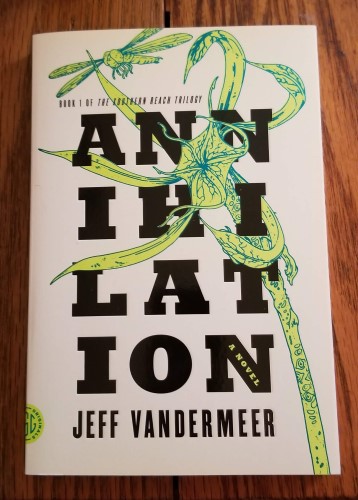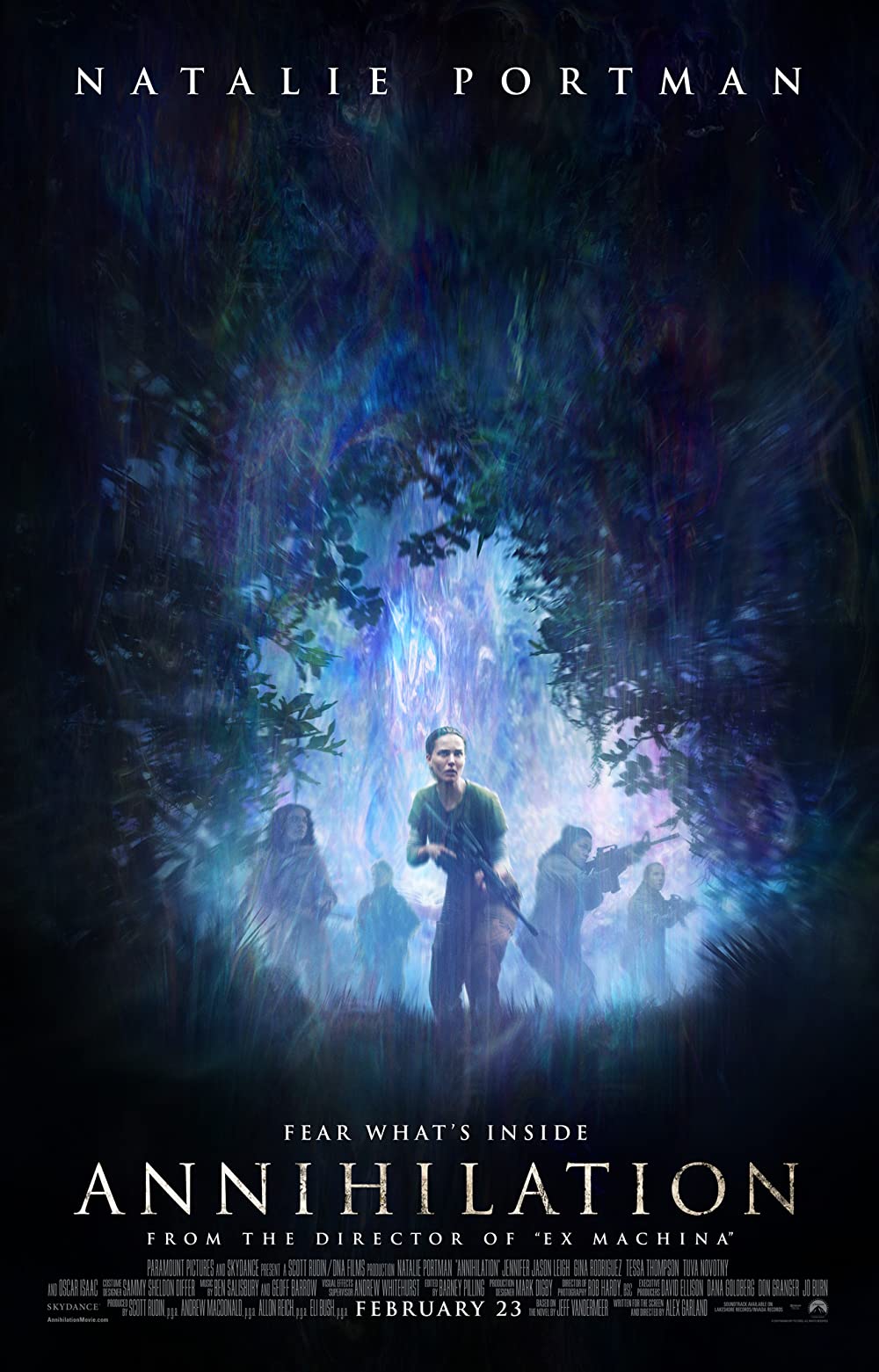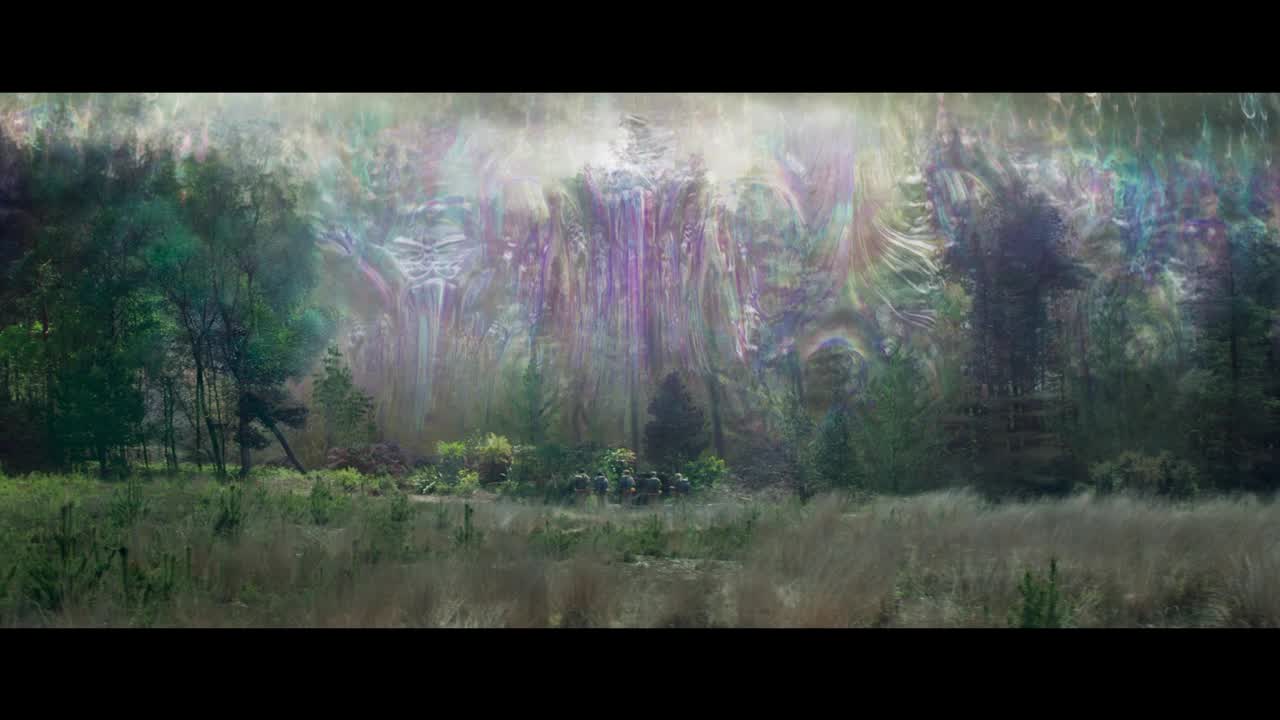Annihilation, the first book in Jeff VanderMeer’s sci-fi/horror Southern Reach series, was published a little over seven years ago. I first read it around that time, ended up reading it again a year or so later, and have had the other two books in the series on my shelf for the last year or so just waiting for the right time to sit down and revisit the series in entirety. During the pandemic’s lock down last year, I had that time and was able to read all three of the books in the series one after the other (yes, I have read the first book three times now and I really could probably read it again – I may be an addict!). I especially wanted to revisit Annihilation in conjunction with the movie, which came out in 2018. After indulging in a deep dive of the books and movie, I came away even more convinced of how effective Annihilation is, and even gathered a few new ideas that kept me thinking about the series long after I was finished. (Note: Spoilers ahead!)
The Book
 Annihilation introduces us to a world where part of the eastern United States seaboard has been significantly changed by an unknown type of event. There is some type of permeable border around the area, which is now called Area X, and a military organization called the Southern Reach has been tasked with controlling and investigating the situation. Scientists have been sent in on expeditions with the hopes that they can record information and report back. Our protagonist is introduced to us as The Biologist, and each member of her expedition is referred to in similar terms by their role: The Psychologist, etc. The story follows the group as they journey into the border zone, a trip that The Biologist undertook with the hope of finding out what happened to her husband, who seemed to have been damaged in some way on his venture into Area X. However, she eventually comes to understand that the being that returned to her from the previous expedition was likely not, in fact, her husband at all.
Annihilation introduces us to a world where part of the eastern United States seaboard has been significantly changed by an unknown type of event. There is some type of permeable border around the area, which is now called Area X, and a military organization called the Southern Reach has been tasked with controlling and investigating the situation. Scientists have been sent in on expeditions with the hopes that they can record information and report back. Our protagonist is introduced to us as The Biologist, and each member of her expedition is referred to in similar terms by their role: The Psychologist, etc. The story follows the group as they journey into the border zone, a trip that The Biologist undertook with the hope of finding out what happened to her husband, who seemed to have been damaged in some way on his venture into Area X. However, she eventually comes to understand that the being that returned to her from the previous expedition was likely not, in fact, her husband at all.
We see Area X through The Biologist’s eyes and it quickly becomes clear the changes that have taken place are both wonderous and terrifying. Electronics do not work within Area X, so all members of the expedition are given paper journals in which to record their findings. The flora and fauna within the area have been altered in ways that would seem to be impossible based upon our current understandings of nature, and it isn’t quite clear that time and space work the same within the area as they do without. As the expedition ventures further, ever more disturbing mutations are encountered, and each of the individual’s personalities begin to change. By the end of the novel we have some answers as to what is happening, but those answers serve only to spawn more questions. My main takeaways from the book:
- One of the most haunting ideas from the novel is “the tower”, which is actually not a tower at all, but rather a sort of bunker with a winding staircase that continues downward for an undisclosed depth. However, for some reason The Biologist cannot help but think of it as “the tower”. Venturing into this anomaly, the explorers encounter writing upon the walls in the form of living flora – a sort of moss or lichen substance that spells out words that have a religious cadence and connotation to them, and which don’t seem to make any real sense while still managing to transfer a feeling of looming terror. This aspect of the book is one that visited my dreams for many nights.
- The religion vs. nature theme that runs underneath the storyline is what I kept returning to as I was reading the novel this time. There is an overwhelming feeling throughout of a god gone mad, or a god with power but no real understanding or humaneness, who has been set loose upon the area making changes to nature at its whim. The religious-like text of the tower lends to this feeling, but there is also The Biologist’s “awakening” after inhaling spores from the vegetation forming the words. It seems that she has been gifted the truth of the new natural order in this area and essentially she becomes privy to an innate revelatory understanding that is beyond attempts of explanation – something very akin to a religious experience. Afterwards she begins the process of converting to someone – something – different than she was before. I can see Area X as the Eden of this mad god, a place where creation serves an unknowable purpose, or possibly no purpose at all. It is not an Eden of human interpretation, but something beyond and alien, something terrifying as the boundaries and limits that we take for granted are removed.
- Some of the most beautiful writing in the book is The Biologist’s discussion of nature. It’s clear that the true love of her life is the natural world. Her journal entries are written to her husband, and her struggle to connect with him in many of the emotional ways that we might find typical in romantic relationships is in sharp contrast to the articulation of her love and appreciation of even the smallest aspects of the natural world. She wants to share it all with him, and her choice of sharing it with him is the best way that she can express her love for him. She marvels at what she sees around her even as she revisits her past attachments to and her reliance on the fulfillment brought to her by experiencing the natural world – her unconscious and innate preference seems to be for a relationship with it over that of a human relationship. However, we get a sense of someone who has a very clear realization of her emotional shortcomings, but for whom those emotions and thoughts for others are, in fact there, only harder to grasp and feel deeply; they are simply more distant for her than for others. This is demonstrated by her continuing search through the piles of journals in the lighthouse in hopes of finding her husband’s journal – one last piece of him to cling to. Despite this, the reality seems to be that she can more easily fall into the rhythms and beauty of a moss filled pool of water than her husband’s eyes, and she knows this and sees how it separates her from what most humans find to be of utmost importance.
The Movie
 The plot for the movie actually follows that of the book to a great extent. Some of the main changes are interpretations of characters, encounters with the remains of previous expeditions within Area X, and a more detailed interpretation of how the changes to flora and fauna manifest along with a suggestion of how it may relate to our own understanding of physics. The ending of the movie, however, is much different than the book with The Biologist returning to the Southern Reach compound, rather than continuing on her journey within Area X. This plot change serves to facilitate the exploration of an interesting concept related to the way that Area X is facilitating changes especially concerning creation (or re-creation) via duplication or twinning, as well as give a hint at the direction for the following books in the series. Some of my observations when comparing the movie to the book:
The plot for the movie actually follows that of the book to a great extent. Some of the main changes are interpretations of characters, encounters with the remains of previous expeditions within Area X, and a more detailed interpretation of how the changes to flora and fauna manifest along with a suggestion of how it may relate to our own understanding of physics. The ending of the movie, however, is much different than the book with The Biologist returning to the Southern Reach compound, rather than continuing on her journey within Area X. This plot change serves to facilitate the exploration of an interesting concept related to the way that Area X is facilitating changes especially concerning creation (or re-creation) via duplication or twinning, as well as give a hint at the direction for the following books in the series. Some of my observations when comparing the movie to the book:
- The Biologist in the movie is much more capable and assured, and much more emotionally and sexually available. One example is the revelation that she has apparently had an affair with a co-worker at some point, something it would be hard to picture The Biologist from the book as being very interested in. Additionally, in the movie we see her waiting for her husband’s return, mourning his loss with music and a search for things to keep herself occupied. It’s painful to watch and shows a depth of emotion that isn’t really available to the character from the text. Her joy when she thinks that her husband has come back to her is well played and very emotional, as is her disappointment when she realizes that something is very, very wrong. We see her struggling through the realization that the one that she loved has not, in fact returned – will never return – at a level that echoes the experiences of many who have seen their partners return from active combat. Overall, The Biologist in the movie is a much more emotionally adept and mature individual with her motivations based more firmly in that humanness.
- The lack of the appearance of “the tower” in the movie made me very sad. However, so much of that aspect of the book is an internal working of thought and perception by The Biologist that it would have been exceptionally hard to capture on film, and the emotions stirred by this plot point of the book would likely have been impossible to fully communicate on film.

- The transmogrification of flora and fauna aspect of Area X is shown in two particularly effective ways with the soldier in the swimming pool, who has been changed (the visceral aspect of his intestinal changes in the flashback is horrifying), died from the horrors of the changes, and then left in a somewhat Christlike pose (an interesting inverted religious visual, here), as well as the bear-creature who mimics the cries for help of its last victim. Both of these were terrifying in their own way: the soldier posed and covered in flowers of all colors after a horrific death – a sharp contrast between beauty and pain; the bear’s disfigured face and borrowed voice – a terrifying new emotionally triggering lure to a ravaging death. Both of these incidents work to bring home the alien nature of whatever has taken over Area X and truly focus on abject displays created by an amoral, “natural” source.
- The twinning theme throughout the movie is very like mirroring rather than cloning or duplicating. The merging of our world with that of Area X is conveyed in an interesting way and it almost seems as if the creator is both copying and modifying with an attempt to improve in some fashion – based upon it’s own, alien values. In some cases this almost appears as a mocking of what we consider natural, as with the changes to the bear and the positioning of the soldier after his murder. This aspect is further emphasized in the last scenes at the lighthouse where the creature that we can assume is at the heart of the spreading changes takes on the appearance of The Biologist, mirrors her and her movements, and duplicates enough of her characteristics as a human to eventually allow for essential self-destruction. While the alien being works to duplicate her, it’s focus seems to be solely on that process, and so as the process and creature evolves The Biologist still retains her individual free will and foresight, which enable her to outsmart the creature and free herself from its trap. All along we have seen that The Biologist has also been in the process of being changed, in this case simply by her presence within Area X, and so what we see at the end of the movie as The Biologist is returned to her would-be husband, Kane, at the Southern Reach compound is another type of mirroring: Kane, we now know, is actually creature trying to be human, while The Biologist is human, but continuing to be slowly transformed into creature.
As you can probably tell, I really love both the movie and the books. I feel like there are just a ton of ideas in this series to think about, so much so that I will be talking more about the next two books in the series – Authority and Acceptance – in another post. Additionally, I was super excited to see a Facebook post from Jeff VanderMeer before Christmas announcing a forthcoming fourth installment in the series – Absolution. I can’t wait to see what’s next!


 The Autopsy of Jane Doe
The Autopsy of Jane Doe Throughout the process, the radio that the duo listens to switches from what sounds like a normal broadcast to an eerie rendition of an old gospel song. Additionally, a huge storm begins to brew and blow outside the funeral home. The lights flicker, go out, and the other corpses in the freezers decide to get up a take a stroll. Here, the outdated use of toe bells on the corpses, which is used humorously by Tommy to give Emma a scare at the beginning, comes back later as an ominous and terrifying signal that the dead are no longer lying peacefully. By the time the storm outside has managed to trap father and son within the funeral home, it’s clear that this Jane Doe has powers within her that are impossible to defend against, and Tommy and Austin are both fated to succumb to her furious revenge as is an unfortunate Emma, returning for her late date with Austin.
Throughout the process, the radio that the duo listens to switches from what sounds like a normal broadcast to an eerie rendition of an old gospel song. Additionally, a huge storm begins to brew and blow outside the funeral home. The lights flicker, go out, and the other corpses in the freezers decide to get up a take a stroll. Here, the outdated use of toe bells on the corpses, which is used humorously by Tommy to give Emma a scare at the beginning, comes back later as an ominous and terrifying signal that the dead are no longer lying peacefully. By the time the storm outside has managed to trap father and son within the funeral home, it’s clear that this Jane Doe has powers within her that are impossible to defend against, and Tommy and Austin are both fated to succumb to her furious revenge as is an unfortunate Emma, returning for her late date with Austin.